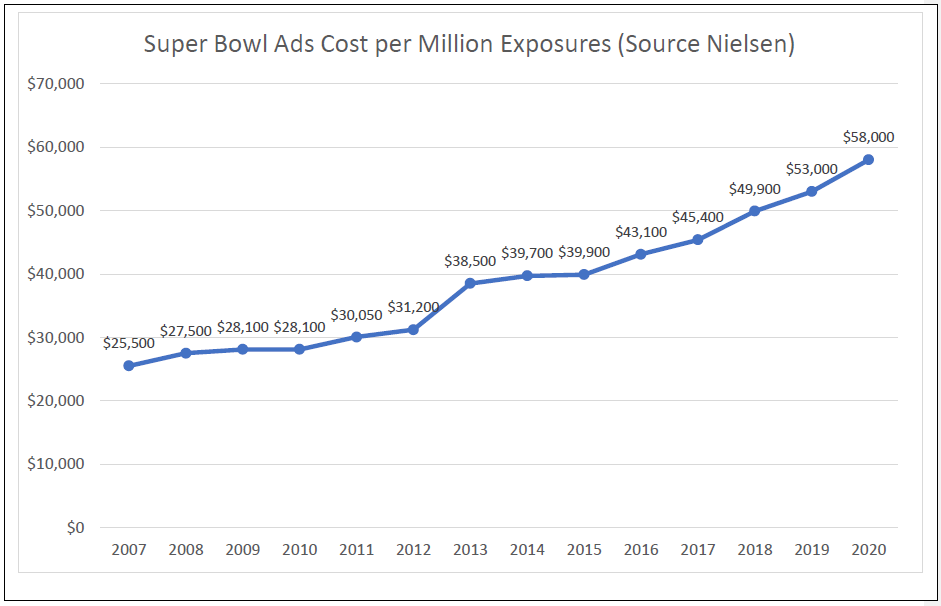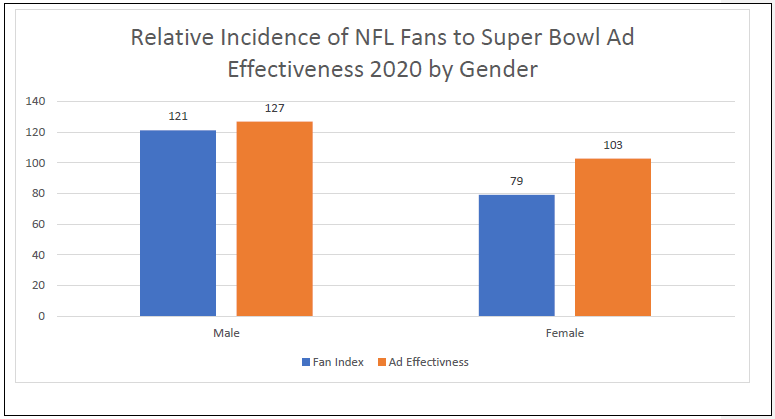This is Michael Wolfe’s annual review of TV commercials for Super Bowl 2020 using data from Advertising Benchmark Index or ABX. Wolfe is CEO of Bottom-Line Analytics and a foremost thinker in the realm of market mix modeling. His purpose here is not just to review ad copy scores of individual ads, but also to understand key lessons of what makes these ads different from ordinary advertising and the special role they play in an advertiser’s marketing mix. For more information, see our informational page

Ad Effectiveness & Super Bowl Audience Trends
In 2020, Nielsen reported Super-Bowl Audience was at 99.9 million. This was up very slightly from the past year; but it wasn’t enough to erase the trend of declining Super Bowl audiences over the past three years. By contrast, ABX tested 60 Super Bowl ads and their collective ad copy effectiveness index stood at 114, a +7 point increase from 2019, and an eight-year high! As shown in the chart below, ad-copy effectiveness has increased, while audience size has declined. This declining audience trend remains a challenge for those who advertise on this medium. It is likely to remain a challenge for future Super Bowl advertisers.

Super-Bowl Advertising Costs and Trends
The attraction and value of Super-Bowl advertising has always been its gigantic audience and ratings. Nevertheless, the cost of a Super-Bowl ad in 2020 reached an all-time record of about $58,000 per million impressions! Overall costs for these TV ad spots have been increasing at an 8 percent annual rate since 2010. Overlaying these steep cost increases with a declining audience is probably the greatest challenge facing the TV networks’ ability to command premium prices for these ads in the years ahead! At least it should be; but so far there is no evidence in reduced ad inflation.

Top Performing 2020 Super Bowl Ads
When we compare the Top Ten Super Bowl ads from 2020 with those of 2019, we see a collective ad copy-effectiveness score of 129 compared to 122: it was a considerable improvement! When we look at the type of ads in this elite group, it shows a more diverse product and brand mix than normally found: no longer is it dominated by beer, soft-drink and auto ads. In fact, in the 2020 Super Bowl, for the first time,included two political ads from Bloomberg and Trump. Interestingly, none of these ads performed very well by the standards of ABX’s copy testing survey.
Cheetos, Tide Detergent, Google, Doritos and Weathertech produced the five top ads with scores within the top 90th percentile of all ABX tested ads since 2012. When compared to common sources of Super-Bowl ad performance published in newspapers and otherwise, ABX’s methodology includes measures of how ads affect a viewer’s propensity to act towards the advertised brand; whereas the other published methods are more based on measures of entertainment value or likeability.

Video clips of the Top 10 ads are shown on the links below to see video clips.
9. Budweiser “Typical American”
10. Little Caesar’s “Best Thing Since Sliced Bread”
Does a Strong Super-Bowl Ad Carry Over into the Year-Ahead?
One of the frequently cited benefits of Super-Bowl advertising is the good-will it brings toward all of a brand’s advertising; and that its impact can actually carry-over into the balance of the year with stronger performing ads. The ABX data shows that top ads score very high on brand reputation from ad viewers.
To answer this question, we looked at the Top 10 ads from the 2019 Super-Bowl and measured each of the top performing brands’ ad effectiveness both prior to and after the Super Bowl event. The chart below illustrates these ads’ overall copy effectiveness trends.
In this chart, we measure each brand’s overall ABX ad effectiveness scores for the year before and after the Super Bowl of 2019. While each brand’s ad effectiveness spiked up during the Super-Bowl, their overall effectiveness after this event tended to be higher than the period before, suggesting that there could very well have been a halo benefit from their strong Super-Bowl ads.

How Super-Bowl Ad Effectiveness maps into the NFL Fan Profile?
If Super-Bowl advertising is directed toward the NFL Football fan, how well does its advertising effectiveness match that profile? How does this match the fans in terms of gender, age and ethnicity?
Gender:
When considering gender, NFL statistics show that males represent 60% of their fan base. Therefore, relative to their 50.5% share of the population, female NFL fans index at just 79 relative to the 121 index for males. In the 2020 Super Bowl, ad effectiveness among males was significantly higher than females. The ad effectiveness by gender therefore maps and aligns with the incidence of NFL fans by gender.

Ethnicity
When we look at NFL fan incidence by ethnicity, the chart below maps the alignment with Super-Bowl ad effectiveness for these groups. As the evidence shows, the NFL fan incidence of African Americans is much higher than their ad effectiveness would suggest, and the opposite is true for Hispanic Americans. This might suggest that advertising creatives need to do a better job of speaking to African Americans via Super-Bowl advertising.

Age
The biggest mismatch when comparing Super-Bowl ad effectiveness with NFL Fan incidence is by age-generation segment. Advertising effectiveness for Super-Bowl ads is significantly higher among younger Millennial and Generation X populations than the older 55+ Baby Boomer group. Yet, the 55+ Boomer group is the strongest core of the NFL Fans. To some extent, this is because advertising creatives for Super Bowl ads are in a contest to create ads which are “cool, funny, entertaining and witty,” which speak more to these younger groups. While the Super-Bowl ads are effective, they do not appear to be efficient. In addition, the more loyal Boomer-age Football fan might be more annoyed with advertising and consider it an unwanted interruption from the time they focus on the game itself?

Final Observations and Insights
Super Bowl advertising has its challenges and, thus far, has not made much headway in overcoming them. These include:
1. A declining trend in audience size and viewership
2. A spiraling increase in ad cost, which exceeds inflation and is a mismatch to the declining audience
3. A gap in Super-Bowl advertising messaging resonating with core NFL fan groups including over 55 Boomers and African Americans.
The overall effectiveness of Super-Bowl advertising has been shown to be no better than advertising across other times of the year. Yet, while Super-Bowl advertising effectiveness has been increasing, this might not be enough. When there are gaps in reaching key fan groups, perhaps the historical formula of just creating ads that are “cool, funny, entertaining and witty” is not enough for navigating future Super Bowls.

Across many years of doing marketing-mix models, I have not found an instance where there has been a positive ROI pay-out to a TV Super-Bowl ad. As we have seen in 4 years of studying these through ABX copy tests, Super Bowl ads do well in driving awareness and getting viewers to talk about their ads; and evidence tends to show that it drives brand reputation and perhaps it has a positive halo on the brand’s future advertising effectiveness. Overall, it still remains an opportunity to penetrate a very large audience with a message. However, Super-Bowl ads are probably missing the mark on the older die-hard football fans and with African-Americans; and declining audience trends will likely remain a challenge to its continued attraction.
Michael Wolfe, CEO of Bottom-Line Analytics, mjw@bottomlineanalytics.com, brings about 30 years of direct experience in marketing analytics on the client, ad-agency and consulting sides. On the former, Michael worked for Coca-Cola, Kraft Foods, Kellogg’s and Fisher-Price. He has also consulted with such blue-chip firms as AT&T, McDonald’s, Coca-Cola, Hyatt Corp., L’Oreal, FedEx and Starbucks. Michael has broad experience in marketing analytics covering marketing ROI modeling, social media analytics, pricing and brand strategy; and he has numerous articles on these subjects.
Are you satisfied with how you are measuring advertising effectiveness? Is it resonating through Awareness and Message, and having an impact on Reputation and Action? ABX provides the largest normative database in the industry across all media types. On average you can improve your creative effectiveness by almost 20%. If you have questions, or would like a quick, informal chat, please click here.

